
Echinochloa crus-galli is a type of wild grass originating from tropical Asia that was formerly classified as a type of panicum grass. It is commonly known as cockspur, barnyard millet, Japanese millet, water grass, common barnyard grass, or simply "barnyard grass". This plant can grow to 60" in height and has long, flat leaves which are often purplish at the base. Most stems are upright, but some will spread out over the ground. Stems are flattened at the base. The seed heads are a distinctive feature, often purplish, with large millet-like seeds in crowded spikelets.

Johnson grass or Johnsongrass, Sorghum halepense, is a plant in the grass family, Poaceae, native to Asia and northern Africa. The plant has been introduced to all continents except Antarctica, and most larger islands and archipelagos. It reproduces by rhizomes and seeds.

The tropical grass species Cenchrus clandestinus is known by several common names, most often Kikuyu grass. It is native to the highland regions of East Africa that is home to the Kikuyu people. Because of its rapid growth and aggressive nature, it is categorised as a noxious weed in some regions. However, it is also a popular garden lawn species in Australia, New Zealand, South Africa and the southern region of California in the United States, being inexpensive and moderately drought-tolerant. In addition, it is useful as pasture for livestock grazing and serves as a food source for many avian species, including the long-tailed widowbird. The flowering culms are very short and "hidden" amongst the leaves, giving this species its specific epithet (clandestinus).

Chloris gayana is a species of grass known by the common name Rhodes grass. It is native to Africa but it can be found throughout the tropical and subtropical world as a naturalized species.
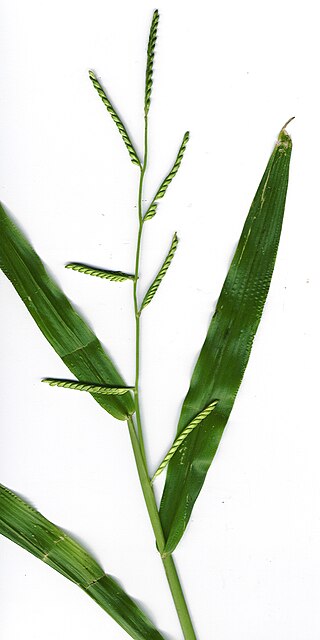
Brachiaria, or signalgrass, is a genus of plants in the grass family native to tropical and subtropical regions of Asia, Africa, Australia, southern Europe, the Americas, and various islands. There are over 100 species.
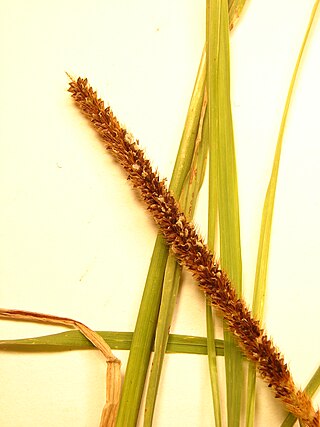
Setaria sphacelata is a tall African grass, also known as South African pigeon grass and African bristlegrass. It is native to tropical and subtropical Africa, and is extensively cultivated globally as a pasture grass and for cut fodder. This is a rhizomatous perennial grass producing flattened, hairless, blue-green stems up to 2 m tall. The inflorescence is a dense, narrow panicle of bristly, orange-tinged spikelets up to 25 cm long.
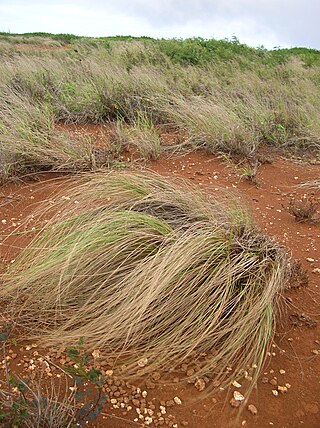
Eragrostis curvula is a species of grass known by the common name weeping lovegrass. Other common names include Boer lovegrass, curved lovegrass, Catalina lovegrass, and African lovegrass.

Leymus angustus is a species of grass known by the common name Altai wildrye. It is native to Asia and Europe and it is cultivated elsewhere as a pasture grass, especially in Canada.
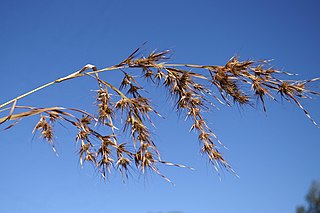
Themeda quadrivalvis is a species of grass known by the common names grader grass, habana grass, and kangaroo grass, not to be confused with Themeda triandra, which is also known as kangaroo grass. It is native to India, Nepal, and Malaysia. It can also be found in many other places as an introduced species and often a noxious weed. It occurs in the United States, New Caledonia, Fiji, Mauritius, Thailand, Indonesia, Papua New Guinea, China, the Middle East and tropical America. It is a troublesome exotic weed in Australia, especially in northern regions. It is also an agricultural weed in crops such as sugar cane and lucerne.

Desmanthus virgatus is a species of flowering plant in the legume family that is known by many common names, including wild tantan, prostrate bundleflower, dwarf koa, desmanto, acacia courant, acacia savane, pompon blank, adormidera, brusca prieta, frijolillo, ground tamarind, guajillo, guashillo, huarangillo, langalet, petit acacia, petit cassie, petit mimosa, virgate mimosa, and slender mimosa, as well as simply desmanthus. It is native to the American tropics and subtropics but is present elsewhere as an introduced species. In some areas it is cultivated as a fodder and forage crop.

Bothriochloa pertusa is a species of grass. It is widely used as a fodder and a graze for livestock.

Urochloa brizantha is a species of grass known by the common name palisade grass. It is often used as a forage for livestock.
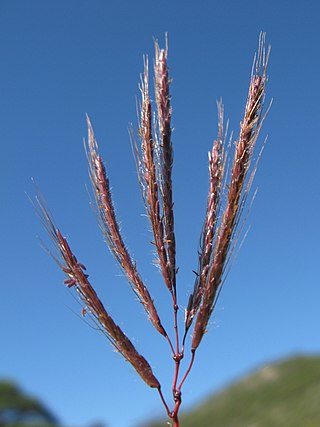
Dichanthium annulatum is a species of grass in the family Poaceae. It is commonly used as a forage for livestock.
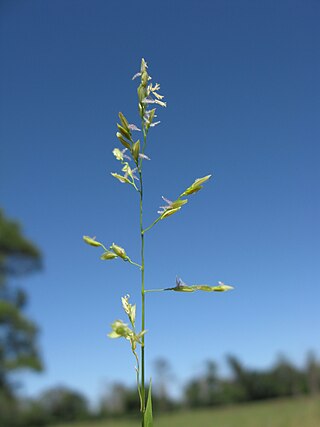
Leersia hexandra is a species of grass known by the common names southern cutgrass, clubhead cutgrass, and swamp rice grass. It has a pantropical distribution. It is also an introduced species in many regions, sometimes becoming invasive, and it is an agricultural weed of various crops, especially rice. It is also cultivated as a forage for livestock.
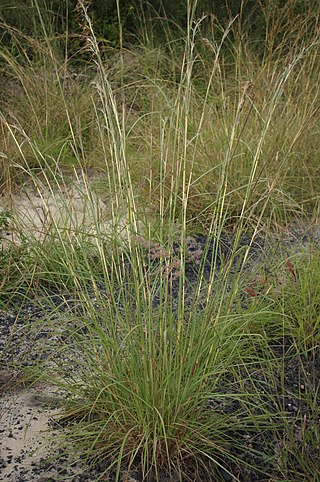
Hyparrhenia rufa is a species of grass known by the common names jaraguá, jaraguá grass, and giant thatching grass. It is native to Africa and it is widespread in the world as a cultivated forage and fodder for livestock and a naturalized and sometimes invasive species.
Brachiaria ruziziensis or Congo grass is a forage crop that is grown throughout the humid tropics. With fast growth at the beginning of the wet season due to strong seedling vigour, ease of establishment, good seed production and yield and the ability to suppress weeds it has the ability to become developed into the most important forage crop planted in the tropics. With the aid of genomic tools to research the genotype and gain more information there is the ability to increase breeding programs which are currently rather limited.

Urochloa nigropedata is a perennial grass belonging to the grass family (Poaceae). It is native to Southern Africa the tropical regions of South Africa and East Africa. Urochloa nigropedata is used as fodder grass in Namibia.

Neustanthus is a monotypic genus of flowering plants belonging to the pea family Fabaceae and its tribe Phaseoleae. The only species is Neustanthus phaseoloides, called tropical kudzu. This species is a forage crop and cover crop used in the tropics. It is known as puero in Australia and tropical kudzu in most tropical regions.

Echinochloa pyramidalis is a species of large grass, occurring naturally in flooded regions and beside lakes in tropical Africa and America, and introduced to various other countries. It is commonly known as antelope grass.

Urochloa ramosa, the browntop millet or Dixie signalgrass, is an annual, millet grass belonging to the grass family (Poaceae). The native range of Urochloa ramosa is from Africa to tropical and subtropical Asia.




















